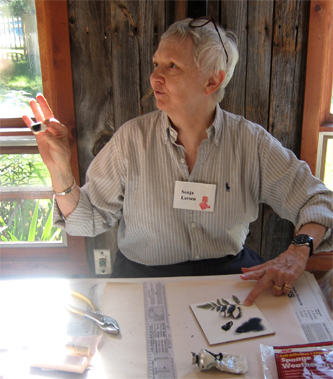If you were able to attend the nature-printing demo at Wet Paint last Saturday, I hope you had as much fun as I did. Thank you for your interest in nature printing and for the beautiful prints you made.
Many good questions were raised throughout the demo. In case you missed hearing a response, a short treatise on dampening your printmaking paper is below. Other topics will be addressed in upcoming posts.
Regarding paper, with the exception of unprinted newsprint and laser paper or stationery papers, paper must be dampened. Dampened paper accepts the ink more readily than does dry paper just as a dampened sponge more readily picks up moisture.
I cut my printmaking paper to fit stock picture frame sizes (5×7″, 8×10″, 12×16″ and so forth). I often mark with a pencil a tiny letter “T” in the lower right corner of each sheet of paper to identify the top side of the sheet. This is important because once a paper is dampened, it is almost impossible to determine which is the top side. And identifying the top side of the paper is important because I want to print on the top side of the sheet. The underside of many papers, particularly Oriental-style printmaking papers, has a velvet-like or fuzzy finish that results in a print that is slightly soft rather than sharp and refined.
The dampening process
Place a plastic food-storage bag (with a zipper top) upside down on a countertop or ironing board covered with a bath towel. (The writing on the bag is pressing against the countertop or towel.) I take a sheet of my cut printmaking paper from a pile that’s also upside down (the side with the tiny “T”s is also facing the countertop), place that sheet on the plastic bag, and spray a fine mist of water onto that sheet of paper. I help myself to another sheet of paper from the pile of cut paper, place it on top of the first sheet of moistened paper, and gently mist that sheet with water. I’m careful to avoid aligning the corners of the sheets of paper because it’s easier to pick up a piece of limp, dampened paper when its corner is protruding from a stack than it is when the corners are squared up with each other.
When I have a stack of moistened paper, I place the stack of paper inside the plastic bag. With the marked top sides of the paper facing the same direction as the writing on the bag, I can confirm which side of the paper is indeed the top. I squeeze any excess air out of the bag before zipping it shut.
I prefer bags with a movable zipper to Ziploc-brand bags (that are closed by squeezing the top’s two sides together) because the zipper-style bags are quick and easy to close, and speed and ease can be important when ink or paint is drying on your specimen! Depending on the weight of the paper, allow at least a half hour for the paper to become evenly moist and cool to the touch. I sometimes place my zippered plastic bag of moistened papers under a weight which seems to enhance the moistening process.
Plan B
If your paper is too large to fit within standard a zipper-style food-storage bag, use a clean plastic shopping bag, a trash or lawn bag, or a bag from a dry cleaner. Squeeze out as much air as possible, close securely, and place under a weight.
If dampened paper is not used within a few hours, store it in the refrigerator to help it retain moisture and prevent mildew. Dampened paper may be safely stored for months in your freezer, a practice alluded to with some mirth by several demo attendees.
